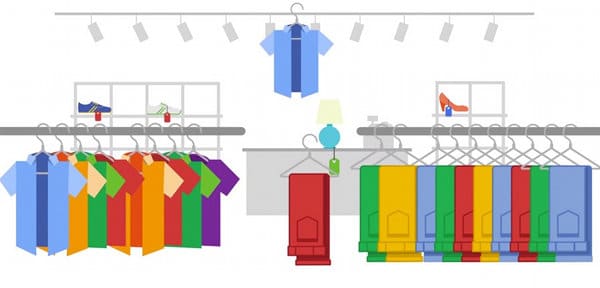15 compulsory attributes for selling on Google Shopping
25/07/14
4'
In order to sell on Google Shopping, online merchants must understand the attributes that correspond to their products, so that they can properly categorise them. Some of these attributes are optional (but highly recommended) and only serve to better position the products in the search results, other attributes, however, are required for your products to appear on Google Shopping.
Some attributes are compulsory for all types of products, while others are only required for certain products, such as clothing, shoes, etc… Here are some tips from the Google Merchant Center.
Reminder: If you use a XML format for your feed or Google Shopping’s API, you must use the English attribute names and separate words using an underscore in place of a space. Example: ‘image_link’ and not ‘Image link’).
Nota : From 16 May 2016, it will be compulsory to integrate GTIN codes. To know more about this, please read our article: “Google Shopping’s New GTIN requirements“
Basic information required on Google Shopping
[ID]
The identifier of each product must be unique in your Merchant Center account and cannot be reused in other feeds from your ecommerce site. If you have multiple feeds, the product identifiers of the various feeds must consist of unique sequences of letters and numbers.
Remember, once a product has been indexed, you must be careful not to change its unique identifier when updating your data feed!
[TITLE]
The title of the product is a mandatory attribute that matches the name of your article. Google recommends including features in your title which will allow a visitor to differentiate your products from others at a glance (colour, size, brand, etc..) Google also advices in it’s editorial guidelines not to add promotional text such as “Free Shipping” or use CAPITAL letters.
[DESCRIPTION]
The product description allows each seller to add relevant information about their products, such as age range, compatibility specs of the product or any other important information to know before buying. It is also a good idea to indicate the visual aspects of the article, for example: the shape, pattern, design or texture.
Product description can contain up to 5000 characters (punctuation included), but Google recommends using between 500 and 1000.
[GOOGLE_PRODUCT_CATEGORY]
The attribute [google_product_category] indicates the category (only one) of your product, which you select out of all the categories defined in the Google product taxonomy. If your items fall into several categories, include only the most relevant category.
All categories must be filled with the full path to the relevant category. For example: “Apparel & Accessories> Clothing> Pants> Jeans” is an acceptable value, but indicating only “Jeans” is not valid.
[PRODUCT_TYPE]
This attribute is also used to indicate product category, but according to your own classification. Here you can include multiple attribute values [product type]. This attribute is not strictly required, but is highly recommended by Google.
[LINK]
The attribute [link] allows you to enter the URL that the user will be redirected to when they click on your article in Google Shopping. It is possible to use tracking URLs to differentiate visitors from Google Shopping.
[MOBILE_LINK]
The URL for mobile will direct the visitor to a site optimised for a mobile terminal. These are pages guarantee a better user experience by reducing the loading time of landing pages and offering a more ergonomic buyer interface. A mobile URL is optional but recommended.
[IMAGE_LINK]
The attribute [image_link] allows you to enter the address of the main image associated with a product. It is also the first image that users see on the product page.
Note: If multiple images are available for your article, it is possible to insert other images using the additional image attribute, like this: [additional_image_link].
Google recommends using images of at least 800 x 800 pixels (250 x 250 pixels for clothing product images).
[CONDITION]
The attribute [condition] allows you to indicate the state of the product being sold. Only three values are accepted in this field:
- [new]: if the product is new and has never been used and has not been removed from it’s original packaging.
- [refurbished]: if the product has been returned to working order.
- [used]: if the product has been used or if the original package is damaged or missing.
[AVAILABILITY]
The availability status of your products should be updated regularly so that users know if their order can be placed and when it will be delivered. Only three values are accepted for the attribute [availability]
- [preorder]: if you accept orders for this product, even if it is not yet distributed. In this case, the attribute [availability date] lets you specify the day on which the product will be shipped.
- [in stock]: if you accept orders for this product and are able to execute orders immediately.
- [out of stock]: if you are not able to accept orders for this product because of insufficient stock.
[PRICE]
The price of the item should be clearly displayed on the landing page and the user must be able to quickly and easily identify the item that interests them and the price corresponding.
[BRAND]
The attribute [brand] is used to indicate the brand of the item (according to unique product code rules) except for Austria, Belgium, Canada, Denmark, India, Mexico , Norway, Poland, Russia, Sweden and Turkey. Be aware that Google forbids putting the name of your store as a brand.
[GTIN]
To sell on Google Shopping, you must indicate the International Product number. The GTIN (Global Trade Item Number) can be specified in one of the following formats depending on the country you are selling in and the type of article:
- UPC (in North America): 12 figure code
- EAN (in Europe): 13 figure code
- JAN (in Japon) : 8 to 13 figure code
- ISBN (for books): 10 to 13 figure code
[MPN]
The manufacturer reference is a required attribute identifies the product to its manufacturer.Note that the number can only be assigned by the manufacturer, not the merchant.
[IDENTIFIER_EXISTS]
The [identifier_exists] attribute is for items belonging to categories for which the unique product code is required, but no such identifier exists for the item. In the absence of unique product code corresponding to their category (GTIN, manufacturer or brand reference), merchants must use the attribute [identifier exists] and enter the value ‘FALSE’.
Your e-commerce library
E-commerce for Retailers
Learn moreE-commerce for Brands
Learn moreL'Oréal Luxe Success Story
Learn moreSign up for our newsletter
By submitting this form you authorize Lengow to process your data for the purpose of sending you Lengow newsletters . You have the right to access, rectify and delete this data, to oppose its processing, to limit its use, to render it portable and to define the guidelines relating to its fate in the event of death. You can exercise these rights at any time by writing to dpo@lengow.com

Trending Posts
Marketing channels
Where does Gen Z shop online?
Gen Z online shopping is transforming the digital marketplace, setting trends that redefine what it means to engage with brands…
16/04/24
9'
Marketplaces
The Top 10 Marketplaces in Europe
The e-commerce scene is a vibrant mix of marketplaces in Europe. These aren't just websites; they're bustling hubs where millions…
08/12/23
7'
Marketplaces
Lengow Now Fully Supports Zalando Logistics Solutions ZSS and ZRS
Zalando, one of Europe’s leading fashion marketplaces, continues to raise the bar with its advanced logistics and fulfillment programs. After…
12/12/24
4'
Marketplaces
How to win the Buy Box on Marketplaces (Amazon, Zalando, etc.)
What is the most important thing for marketplace sellers? Exactly, the Buy Box! If you don't have the Buy Box…
02/04/24
10'
Marketplaces
How to Sell on Temu? Best Tips
Emerging under the vast umbrella of PDD Holdings Inc., Temu has skyrocketed in popularity as a shopping sensation from China…
17/08/23
5'







